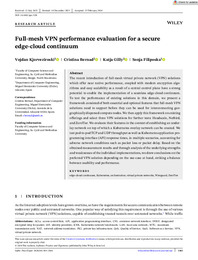Por favor, use este identificador para citar o enlazar este ítem:
https://hdl.handle.net/11000/35419Registro completo de metadatos
| Campo DC | Valor | Lengua/Idioma |
|---|---|---|
| dc.contributor.author | Gilly, Katja | - |
| dc.contributor.author | Kjorveziroski, Vojdan | - |
| dc.contributor.author | Bernad, Cristina | - |
| dc.contributor.author | Filiposka, Sonja | - |
| dc.contributor.other | Departamentos de la UMH::Ingeniería de Computadores | es_ES |
| dc.date.accessioned | 2025-01-28T18:24:35Z | - |
| dc.date.available | 2025-01-28T18:24:35Z | - |
| dc.date.created | 2024 | - |
| dc.identifier.citation | Software: Practice and Experience | es_ES |
| dc.identifier.issn | 0038-0644 | - |
| dc.identifier.issn | 1097-024X | - |
| dc.identifier.uri | https://hdl.handle.net/11000/35419 | - |
| dc.description.abstract | The recent introduction of full-mesh virtual private network (VPN) solutions which offer near native performance, coupled with modern encryption algorithms and easy scalability as a result of a central control plane have a strong potential to enable the implementation of a seamless edge-cloud continuum. To test the performance of existing solutions in this domain, we present a framework consisted of both essential and optional features that full-mesh VPN solutions need to support before they can be used for interconnecting geographically dispersed compute nodes. We then apply this framework on existing offerings and select three VPN solutions for further tests: Headscale, Netbird, and ZeroTier. We evaluate their features in the context of establishing an underlay network on top of which a Kubernetes overlay network can be created. We test pod-to-pod TCP and UDP throughput as well as Kubernetes application programming interface (API) response times, in multiple scenarios, accounting for adverse network conditions such as packet loss or packet delay. Based on the obtained measurement results and through analysis of the underlying strengths and weaknesses of the individual implementations, we draw conclusions on the preferred VPN solution depending on the use-case at hand, striking a balance between usability and performance. | es_ES |
| dc.format | application/pdf | es_ES |
| dc.format.extent | 22 | es_ES |
| dc.language.iso | eng | es_ES |
| dc.publisher | Wiley | es_ES |
| dc.relation.ispartofseries | 54 | es_ES |
| dc.relation.ispartofseries | 8 | es_ES |
| dc.rights | info:eu-repo/semantics/openAccess | es_ES |
| dc.rights | Attribution-NonCommercial-NoDerivatives 4.0 Internacional | * |
| dc.rights.uri | http://creativecommons.org/licenses/by-nc-nd/4.0/ | * |
| dc.subject | edge-cloud continuum | es_ES |
| dc.subject | Kubernetes | es_ES |
| dc.subject | orchestration | es_ES |
| dc.subject | virtual private networks | es_ES |
| dc.subject | Wireguard | es_ES |
| dc.subject | ZeroTier | es_ES |
| dc.subject.other | CDU::6 - Ciencias aplicadas::62 - Ingeniería. Tecnología | es_ES |
| dc.title | Full-mesh VPN performance evaluation for a secure edge-cloud continuum | es_ES |
| dc.type | info:eu-repo/semantics/article | es_ES |
| dc.relation.publisherversion | https://doi.org/10.1002/spe.3329 | es_ES |

Ver/Abrir:
Softw Pract Exp - 2024 - Kjorveziroski - Full‐mesh VPN performance evaluation for a secure edge‐cloud continuum.pdf
2,32 MB
Adobe PDF
Compartir:
 La licencia se describe como: Atribución-NonComercial-NoDerivada 4.0 Internacional.
La licencia se describe como: Atribución-NonComercial-NoDerivada 4.0 Internacional.
.png)